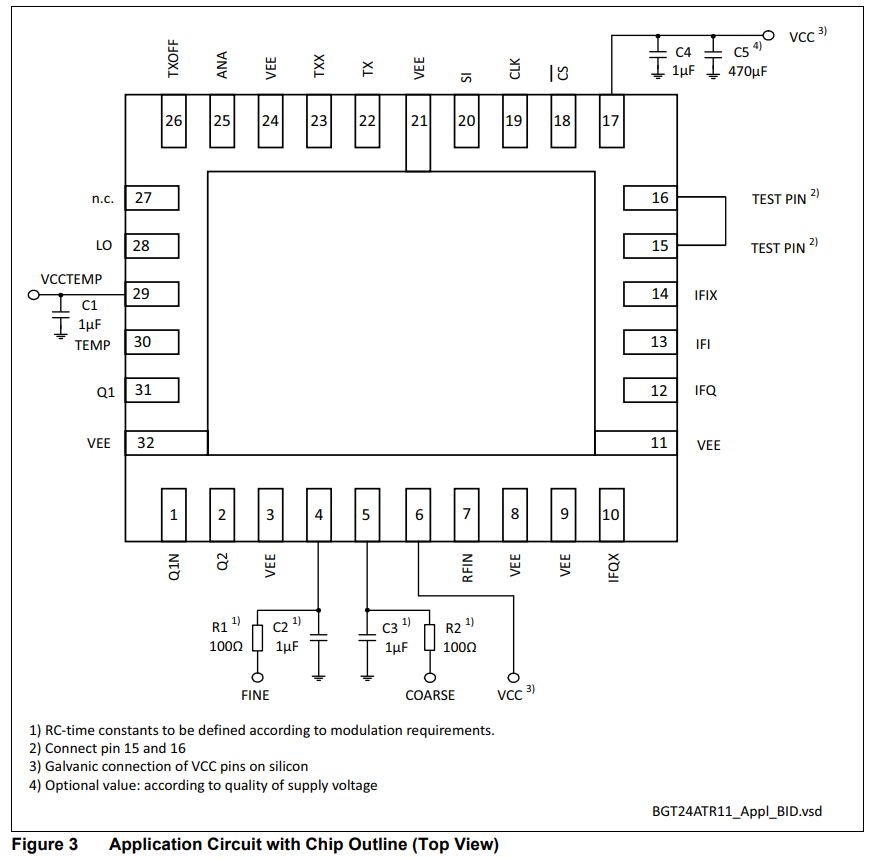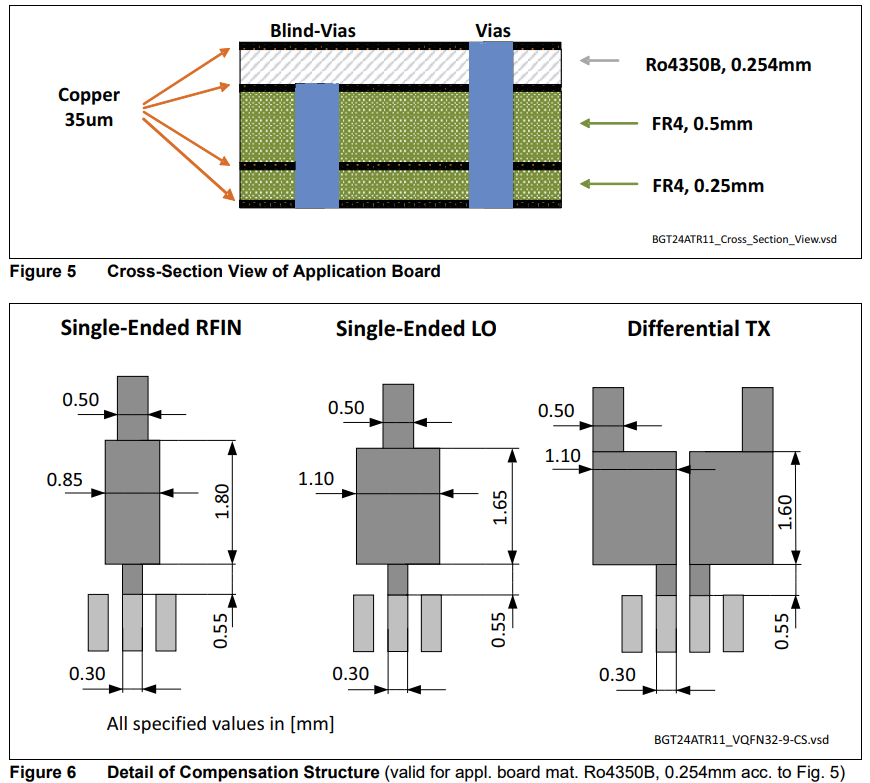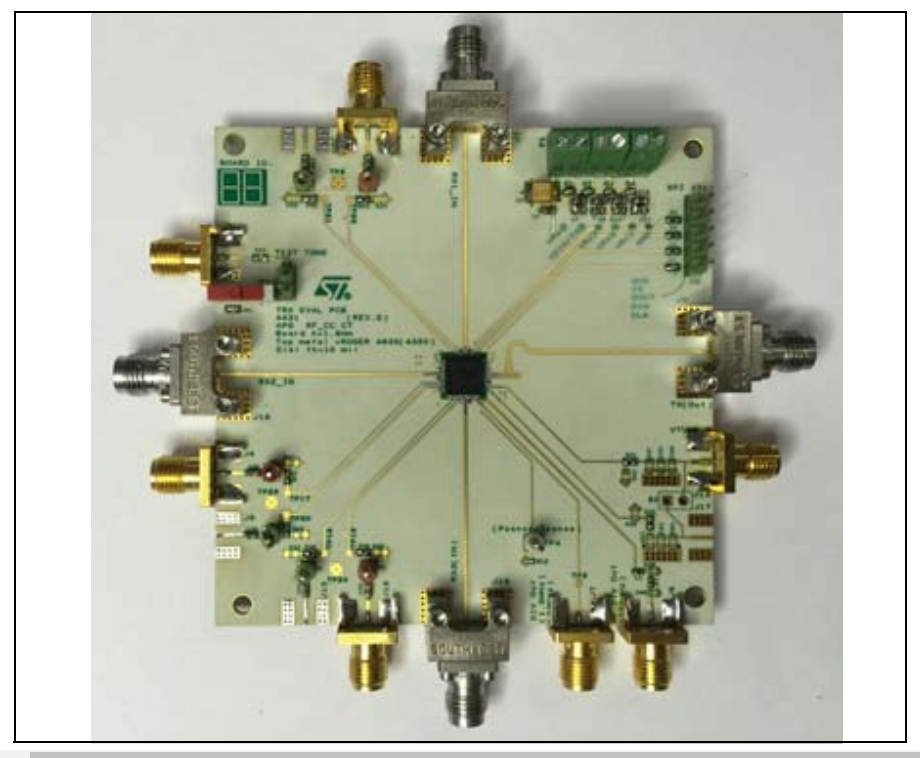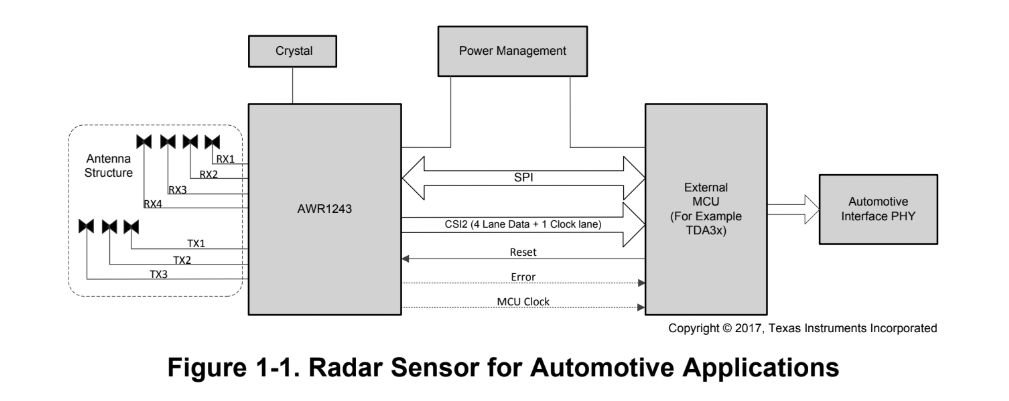
Monolithic microwave integrated circuits (MMICs) are circuits integrated into small packages for operation at microwave frequencies. Microwave frequencies are identified as the range from 300 MHz to 300 GHz in the radio frequency spectrum. While MMICs may use radar in devices from cell phones to satellites, this article will focus on their use in automobiles. MMICs are used in automotive applications for sensing the environment within and around the automobile. By sensing the environment using MMICs, surrounding objects may be identified. Data such as distance and speed are collected for use and response by increasingly-available smart cars.
Microwave radar sensors for automotive applications typically use either 24 GHz for short-range or 77 GHz for long-range detection. MMICs typically incorporate an onboard low-dropout regulator (LDO) and an analog-to-digital converter (ADC) to condition signals before sending to a digital signal processor (DSP) within the overall radar system block, an embedded system within the car.
Background for MMICs and Autonomous Vehicles
MMIC technology resulted from the invention of transistor technology using gallium arsenide. It uses microwave radar to sense distance and speed, using MMICs to transmit and receive within the system. The first was invented and used in the 1970s, and it used gallium arsenide material for its ability to work at high speed with minimal noise. Gallium arsenide had a semi-insulating substrate, keeping noise and heat to a minimum. The channels were tuned using integrated discretes etched into the material within the layers of the transistor.
Today, silicon vendors are offering mmWave technology for use in MMICs made from CMOS. This latest mmWave CMOS is able to integrate high-frequency front ends with higher transistor density. In addition, much less power is required to drive higher transistor densities resulting in more functionality. The newest silicon mmWave material is also able to integrate high-quality passives needed for accurate channel tuning within the higher frequency bandwidths.
Microwave radar is used together with cameras for vision sensing and with UHF wireless devices for communications in autonomous automobiles. Together the three technologies work together to provide automobiles information necessary to drive autonomously without human interaction. It is an emerging technology not yet widely available. However, the market is starting to offer smart cars to consumers. At present, we have automobiles available with advanced driver-assistance systems (ADAS) where a combination of autonomous technologies are used together with driver monitoring while operating the vehicle.
 MMICs provide sensory functions for smart cars
MMICs provide sensory functions for smart cars
Defining Characteristics of MMICs For Automobiles
MMICs use microwave frequencies to transmit and receive information for detection and localization of objects using radio waves. They are typically arranged at the four corners of the vehicles and are sometimes included on each side of the car as part of its automotive radar. Incorporating MMIC design into your vehicle can be an adaptive and easily utilizable process.
Autonomous automobiles use both short-range and long-range MMICs. Using short-range radar operating with a center frequency of 24 GHz, the MMICs perform blind spot monitoring, lane and lane-change assist, collision warning and avoidance, parking assist, and cross-traffic monitoring. With long-range range operating at a center frequency of 77 GHz, MMICs provide brake assist, emergency braking, and automatic distance control.
MMICs for use in autonomous automobiles are characterized by:
ADC: Analog-to-Digital converter. A system that converts an analog signal, such as a radio frequency wave, into a digital signal.
CMOS: Complementary Metal Oxide Silicon.
DSP: Digital Signal Processor. A specialized microprocessor used to measure, filter, or compress continuous real-world analog signals.
ISM: Industrial, scientific, and medical radio band that refers to a group of radio bands or parts of the radio spectrum that are internationally reserved for the use of radio frequency (RF) energy intended for ISM rather than for communications.
LDO: Low-Dropout. An LDO regulator is a DC linear voltage regulator that can regulate the output voltage even when the supply voltage is very close to the output voltage.
MMIC: Monolithic Microwave Integrated Circuit. A type of integrated circuit device that operates at microwave frequencies (300 MHz to 300 GHz).
MRR/LRR: Mid-range radar / Long-range radar. Part of the ISM microwave radio frequency band with center frequency of 77 GHz.
RADAR: Radio Detection and Ranging. The detection and localization of objects using radio waves.
RFCMOS: Radio Frequency complementary metal oxide silicon.
SiGe: Silicon Germanium.
SRR: Short-range radar. Part of the ISM microwave radio frequency band with center frequency of 24 GHz.
 Read the paper while MMICs drive your car
Read the paper while MMICs drive your car
Parameters to Consider When Selecting MMICs
Using MMIC technology incorporates microwave bandwidths operating around a center frequency of either 24 GHz for short range or 77 GHz for long range. Each defined band contains channels within its bandwidth. This necessitates accurate filtering elements built into the material. Resistor-capacitor polyphase filters are used within MMICs to create matrices for accurate tuning channels.
Automobiles use MMICs within dynamic systems that interact with other cars, vehicles, and pedestrians. As more devices are becoming smart, more MMICs are present within the environment. This results in MMICs available with both transmit and receive functionality for use within their respective embedded systems.
FMCW: Frequency-Modulated Continuous-Wave. A special type of radar sensor which radiates continuous transmission power like a simple continuous wave radar and modulates during transmission.
LNA: Low noise amplifier. Amplifies weak signals from an anntenna and boosts them from a more useful voltage.
LO: Local oscillator. An electronic oscillator used with a mixer to change the frequency of a signal.
PLL: Phase locked loop. A control system that generates an output signal whose phase is related to the phase of an input signal.
RCPPF: Resistor-capacitor polyphase filter. A matrix of resistor-capacitor combinations used as a filter band.
QFN: Quad-Flat No-Lead. A type of flat no-lead integrated circuit package that physically and electrically connects integrated circuits to printed circuit boards.
RoHS: Restriction of Hazardous Substances. Short for Directive on the restriction of the use of certain hazardous substances in electrical and electronic equipment.
RX: Receive. A node on the MMIC that receives radio-frequency signals.
SPI: Serial Peripheral Interface. This is a synchronous serial communication interface specification used for short distance communication, primarily in embedded systems.
TX: Transmit. A node on the MMIC that transmits radio-frequency signals.
VQFN: Very thin quad flat no-lead is a type of IC package that physically and electrically connect integrated circuits to printed circuit boards.
Next, we'll take a look at several parts offered by today’s vendors.
Infineon BGT24ATR11 Silicon Germanium 24 GHz Transceiver MMIC
This is a short-range MMIC with center frequency of 24 GHz.
The BGT24ATR11 is a Silicon Germanium MMIC for signal generation and reception, operating in the 24 GHz ISM band from 24.00 to 24.25 GHz. It is based on a 24 GHz fundamental voltage controlled oscillator. Switchable frequency prescalers are included with output frequencies of 1.5 GHz and 23 kHz. The main RF output delivers typically 11 dBm signal power to feed an antenna and an auxiliary LO output is available to provide LO signal to separate receiver components.
An LNA provides low noise figure and an RC polyphase filter is used for LO quadrature phase generation of the homodyne quadrature downconversion mixer. Output power sensors, as well as a temperature sensor, are implemented for monitoring purposes. The device is controlled via SPI and is manufactured in a 0.18µm SiGe:C technology offering a cutoff frequency of 200 GHz. The MMIC is packaged in a 32 pin leadless RoHS compliant VQFN package.
The BGT24ATR11 may be exercised for eventual application in your design by using the application circuit schematic, along with PCB layout, shown below:


ST Microelectronics STRADA431-TR, 24-GHz Transceiver MMIC
This is a short-range MMIC with 24 GHz center frequency.
STRADA431 is a fully integrated 24-GHz transceiver for ISM automotive radar applications. It embeds 24-GHz frequency generation, a power amplifier, and three receivers with IF filters and variable gain functions. It also contains LDOs to supply the internal core and it is fully configurable via a simple SPI interface.
STRADA431 is fabricated in 0.13µm SiGe:C technology and assembled in QFN 40 leads, 6x6mm2, 0.5mm pitch package with wettable flanks feature.
An evaluation kit is available from the MMIC vendor, the EVB-STRADA431 evaluation kit, described here. The evaluation board includes SMA connectors typically used to transmit and receive from the MMIC, as well as access to IF output and other internal signals of interest for evaluation during development. The kit includes GUI software programs allowing integrated development via USB to and from any computer.
 EVB-STRADA431 Evaluation Board
EVB-STRADA431 Evaluation Board
Texas Instruments, AWR1243, 76-to-81 GHz High-Performance Automotive MMIC
This is a long-range MMIC with 77 GHz center frequency. It recently became a CES 2018 innovation award honoree.
The AWR1243 device is an integrated single-chip FMCW transceiver capable of operation in the 76- to 81-GHz band. The device enables unprecedented levels of integration in an extremely small form factor. AWR1243 is an ideal solution for low power, self-monitored, ultra-accurate radar systems in the automotive space. The AWR1243 device is a self-contained FMCW transceiver single-chip solution that simplifies the implementation of Automotive Radar sensors in the band of 76 to 81 GHz. It is built on TI’s low-power 45-nm RFCMOS process, which enables a monolithic implementation of a 3TX, 4RX system with built-in PLL and A2D converters. Simple programming model changes can enable a wide variety of sensor implementation (Short, Mid, Long) with the possibility of dynamic reconfiguration for implementing a multimode sensor. Additionally, the device is provided as a complete platform solution including reference hardware design, software drivers, sample configurations, API guide, and user documentation.

The AWR1243 is AECQ100 qualified for automobiles and is useful for highway driving and automatic emergency braking. Its advanced features include embedded self-monitoring with no host processor involvement, complex baseband architecture, the option of cascading multiple devices to increase channel count, and embedded interference detection capability. It has a built-in LDO network and supports dual voltage I/Os with 3.3V and 1.8V rails. It operates with a 40.0 MHz crystal.
MMICs are microwave transceivers used in the automotive industry to provide sensory functions using radar. The parts are made from either Silicon Germanium or CMOS material, and vendors continue to develop CMOS alternatives to Silicon Germanium for both transistor density and cost savings.
Stay up-to-date with our latest articles by signing up for our newsletter.